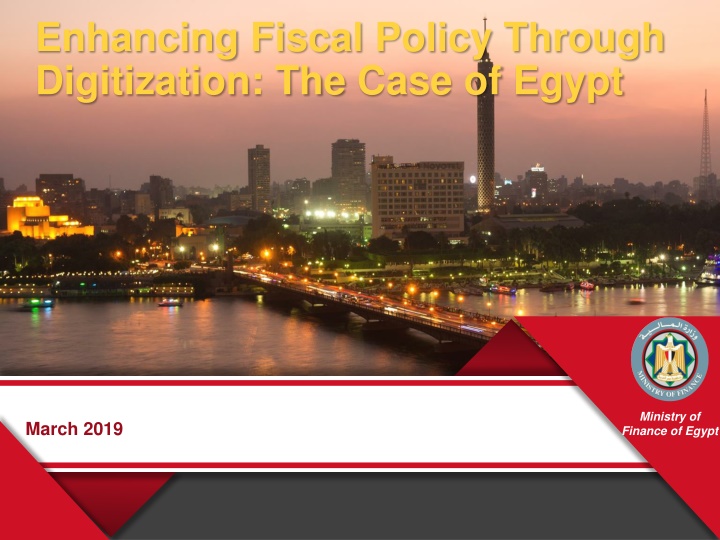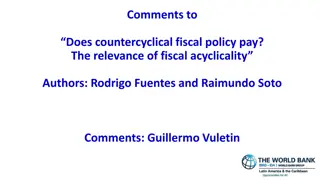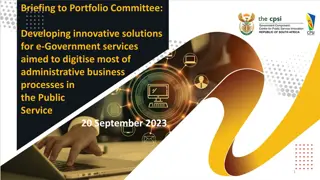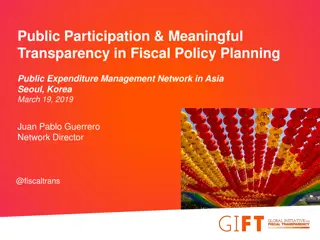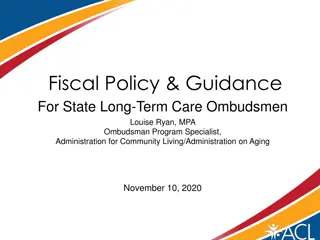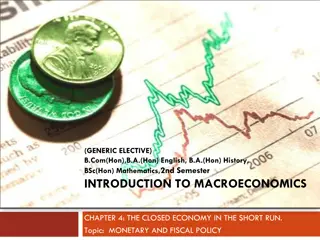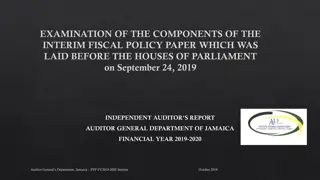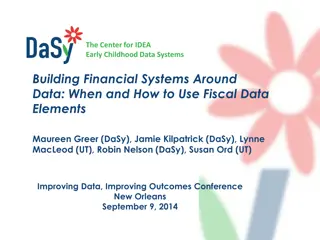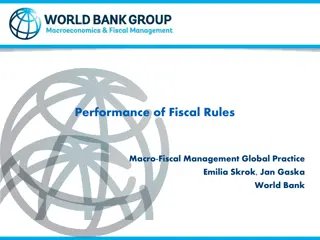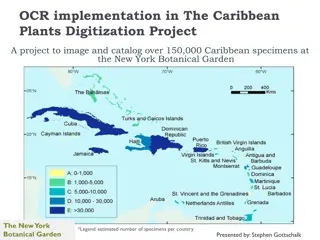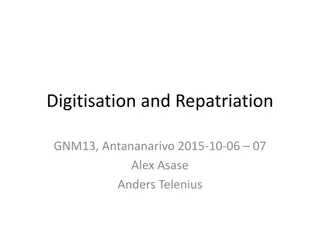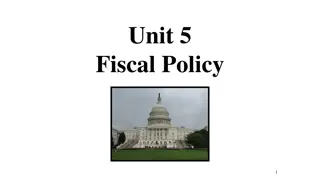Enhancing Fiscal Policy Through Digitization in Africa
African countries aim to bridge the financing gap for achieving Sustainable Development Goals by leveraging digital technology for revenue mobilization and tax policy reform. While digital tools offer opportunities to enhance tax administration, unique challenges of the digital economy must be addressed by rethinking taxation frameworks.
Download Presentation

Please find below an Image/Link to download the presentation.
The content on the website is provided AS IS for your information and personal use only. It may not be sold, licensed, or shared on other websites without obtaining consent from the author.If you encounter any issues during the download, it is possible that the publisher has removed the file from their server.
You are allowed to download the files provided on this website for personal or commercial use, subject to the condition that they are used lawfully. All files are the property of their respective owners.
The content on the website is provided AS IS for your information and personal use only. It may not be sold, licensed, or shared on other websites without obtaining consent from the author.
E N D
Presentation Transcript
Enhancing Fiscal Policy Through Digitization: The Case of Egypt Ministry of Finance of Egypt March 2019
Agenda Digital Economy Opportunities and challenges 1 Egypt Economic and Social Reform Program 2 3 Macro-fiscal Results of Program Implementation The Way Forward 4 2
(1) Digital Economy Opportunities and challenges 3
Digital Economy Opportunities and challenges Countries in Africa have a little more than a decade to achieve the Sustainable Development Goals, which are aimed at lifting millions of Africans out of extreme poverty, reducing inequality and enhancing sustainable development. Notwithstanding the effects of fiscal reforms, which resulted in an increase in revenue to gross domestic product ratios to an annual average that exceeds 15% between 2000 and 2017, there remains a significant financing gap to bridge in order to achieve the Goals. Experiences across the globe demonstrate that fiscal policy effectiveness and efficiency can significantly benefit from digitization processes. African countries have the potential to increase tax revenues by between 3% and 4%, by bringing into the tax bracket the hard to tax sectors such as agriculture and the digital economy, and the informal sectors. The use of digital technology alone has the potential to raise fiscal revenue by a similar percentage. 4
Digital Economy Opportunities and challenges 1. Opportunities: The use of digital technology in revenue mobilization and management could potentially strengthen the capacity of African Governments to implement and monitor more effective tax and expenditure policies. Digital technology, especially in big data analytics, has the potential to increase revenue and improve tax administration through: - lowering the cost of compliance, - lowering the cost of tax collection, - Increasing compliance. Through big data analytics, revenue authorities can identify new sources of revenue, in addition to being able to deepen engagement with current and potential taxpayers, in a cost- effective way. 5
Digital Economy Opportunities and challenges 2. Challenges: The digital economy, however, presents several challenges that make it difficult for Governments to collect revenue. It has certain attributes and among them: - The use of data, the value of which is often difficult to estimate, - The ability to conduct business without a physical presence. At present, tax policies in most countries in Africa are aimed at a more traditional economy, and do not consider the distinctive nature of the digital economy, resulting in loss of revenue for Governments. Accordingly, Governments need to rethink their taxation frameworks with the aim of accommodating the digital economy. 6
(2) Egypt Economic and Social Reform Program 7
Economic Reform Program During the past two years, the Egyptian government started a comprehensive economic and social reform program, that aims at enhancing competitiveness of the Egyptian economy addressing macroeconomic infrastructure base and public services, and improving our human capital base. imbalances, upgrading our This reform program will help Egypt achieve its sustainable development goals (SDGs) targets and contribute to better living conditions for our people. Particularly, Egypt's fiscal reforms aim at improving the structure of the budget, while allowing the redirection of part of the savings to finance a number of social programs. 8
Objectives of the Economic Reform Program: Stability, inclusion, and structural reforms to support competitiveness & job creation Key Reform Pillars Growth spending and enhancing of revenues Controlling inflation and establishing a flexible ER regime competitiveness Securing reliable energy supplies over the medium term friendly rationalization of to maintain Robust & Stable macro- economic indicators Improving and easing the business environment Stabilization on tax policies Infrastructure development with expanding private sector role Streamlining and supporting manufacturing base Encouraging export-oriented sectors Supporting SMEs and Entrepreneurship UHC for all the population New modern education system Social security pensions reforms Cash transfer programs Social Housing Project Increasing spending on education and health Reform Program Deepening Structural Reforms (Industry, Investments & Exports) Social Inclusion (efficient and targeted protection for low income groups) 9
Key reforms have been implemented to address Egypts structural imbalances Floatation of the currencyNovember 2016 Elimination of capital controls including the repatriation mechanism VAT Law Eliminating regressive and inefficient energy subsidy Implementation of increase for the fifth year in a row Announced two comprehensive social packages Launched a comprehensive tax policy and administrative reform. the electricity tariff 10
(3) Macro-fiscal Results of Program Implementation 11
A higher and more resilience growth path Implemented reforms and restored confidence in the economy are driving strong and diversified growth recovery. We have achieved 5.3% real growth in 2017/2018, the highest rate since the financial crisis. Real growth rate (%) 7.0 6.0 5.0 4.0 6.0 3.0 5.6 5.5 5.3 4.4 4.3 4.2 2.0 2.3 1.0 0.0 2011-2014 (Average) 2014/2015 2015/2016 2016/2017 2017/2018 2018/2019 Est. 2019/2020 Proposed Budget H1 - 2018/2019 12
Growth is becoming more diversified with higher investment contribution Economic growth has been broadly balanced with investments contributing almost 50% of realized growth for the first time in years. Net exports also switched to contribute positively to growth after years of being a drag. Sources of real economic growth (%) Net exports Investments Final consumption 7.0 6.0 1.2 1.1 5.0 1.3 4.0 4.3 3.7 2.5 2.3 3.0 3.4 2.4 2.0 2.3 2.2 1.0 1.8 1.7 1.7 1.2 0.0 -0.2 -1.3 -1.6 -1.0 -2.0 2014/2015 2015/2016 2016/2017 2017/2018 2018/2019 estimates 2019/2020 Proposed Budget 13
A decelerating unemployment rate and creating more real jobs With the pick-up in growth rate that is job rich, unemployment rates are trending downward to reach 8.9% by end December 2018, marking its lowest rate since 2010. Unemployment Rate (%) 13.3 13.3 13.5 12.7 12.6 12.5 12.5 12.0 11.5 10.5 9.9 9.6 9.5 9.1 8.9 8.5 7.5 6.5 2011/2012 2012/2013 2013/2014 2014/2015 2015/2016 2016/2017 2017/2018 2018/2019 Estimates 2019/2020 Proposed Budget December 2018 14
A significant fiscal consolidation is ongoing driven by long-lasting reforms on revenues & expenditure sides Overall Deficit and Primary Balance (Excluding Grants) (% of GDP) 20% Overall Deficit (Excluding Grants) Primary Balance (Excluding Grants) 16.5% 15% 13.2% 12.7% 12.5% 11.4% 10.6% 10.0% 9.8% 10% 8.4% 8.3% 7.2% 5.3% 4.6% 4.3% 3.8% 5% 3.7% 2.3% 0% -2% -0.04% -2% -5% 2010/2011 2011/2012 2012/2013 2013/2014 2014/2015 2015/2016 2016/2017 2017/2018 2018/2019 Proposed Budget Est. 2019/2020 15
July-February consolidation is on track outturns confirm that Egypt s fiscal Primary Surplus as percent of GDP (%) Overall Deficit as percent of GDP (%) 7.0% 0.8% 0.5% 6.5% 6.5% 0.4% 6.0% 5.8% 0.0% 5.5% -0.3% -0.4% 4.9% 5.0% -0.8% 4.5% -1.2% 4.0% -1.2% -1.6% 3.5% July-February 16/17 July-February 17/18 July-February 18/19 July-February 16/17 July-February 17/18 July-February 18/19 16
Debt to GDP declined by 10% in 2017/18 due to pick up in economic growth & ongoing fiscal consolidation Total Budget Sector Debt (% of GDP) Total Domestic Budget Sector Debt Total External Debt serviced by MoF % of GDP 120% 120.0% 108.0% 110% 110.0% 102.8% 97.2% 100% 100.0% 7.9% 18.0% 93.1% 92.5% 89.3% 89.2% 88.1% 90% 90.0% 7.8% 19.0% 82.0% 9.6% 16.9% 10.6% 78.0% 15.3% 80% 80.0% 11.6% 9.1% 94.9% 70% 90.0% 70.0% 85.2% 79.7% 78.2% 77.5% 75.7% 73.9% 60% 60.0% 70.4% 68.9% 50% 50.0% 2011/2012 2010/2011 2012/2013 2013/2014 2014/2015 2015/2016 2016/2017 2017/2018 2018/2019 Proposed Budget Est. 2019/2020 17
Non-sovereign tax revenues is picking up, targeting an increase of 0.5% of GDP next fiscal year Sovereign and Non-Sovereign Tax Revenues Total Non-Sovereign Tax Revenues Total Sovereign Tax Revenues Total Sovereign Tax Revenues (% of GDP) Total Non-Sovereign Tax Revenues (% of GDP) 1500.0 15.0% 11.0% 10.5% 1300.0 9.4% 8.9% 8.8% 10.0% 1100.0 4.7% 4.4% 4.2% 3.9% 5.0% 3.0% 900.0 181.9 700.0 0.0% 205.2 209.7 500.0 -5.0% 151.6 675.8 300.0 114.7 549.8 419.6 -10.0% 310.4 237.6 100.0 2015/16 2016/17 2017/18 2018/19 Est. 2019/20 -100.0 -15.0% Proposed Budget 18
On the external side, current account deficit is narrowing significantly Current Account Deficit excluding Official Transfers (Grants) 25.0 7.0% 6.2% US$ Billion 6.0% 6.0% % of GDP 20.0 4.9% 4.5% 5.0% 3.9% 15.0 4.0% 2.5% 2.9% 2.5% 3.0% 10.0 19.9 2.0% 14.8 14.7 14.5 2.0% 10.8 5.0 7.2 1.0% 6.8 6.2 5.8 0.0 0.0% 2010/11 2011/12 2012/13 2013/14 2014/15 2015/16 2016/17 2017/18 2018/19 forecast 19
Driven by improvements in Egypts key foreign exchange inflows Tourism Receipts (% of GDP) Non-oil exports (% of GDP) 5.0% 3.9% 6.9% 7.5% 6.5% 3.4% 4.0% 3.4% 6.5% 3.0% 5.0% 2.2% 4.9% 5.5% 1.9% 4.5% 1.7% 2.0% 4.0% 3.9% 4.5% 1.1% 1.0% 3.5% 2.5% 0.0% 2011/2012 2012/2013 2013/2014 2014/2015 2015/2016 2016/2017 2017/2018 2011/2012 2012/2013 2013/2014 2014/2015 2015/2016 2016/2017 2017/2018 Workers' Remittances (% of GDP) Portfolio Investments (% of GDP) 11.5% 8.0% 6.8% 10.6% 7.0% 10.5% 6.0% 4.9% 9.3% 5.0% 9.5% 4.0% 8.5% 3.0% 2.0% 7.5% 0.5% 0.4% 6.5% 6.4% 1.0% 6.1% 6.5% 5.8% 0.0% 5.2% -1.0% -0.2% 5.5% -0.4% -2.0% -1.8% 2011/2012 4.5% -3.0% 2011/2012 2012/2013 2013/2014 2014/2015 2015/2016 2016/2017 2017/2018 2012/2013 2013/2014 2014/2015 2015/2016 2016/2017 2017/2018 Source: Central Bank of Egypt 20
These led to pick-ups in Net International Reserves to reach a high of $ 44.1 billion by end Feb. 2019, more than 8 months of imports coverage Net International Reserves US$ Billion Months of Imports 50.0 10.0 8.6 8.5 8.5 8.4 8.4 8.4 8.1 8.1 45.0 8.0 6.4 5.9 40.0 6.0 3.9 3.7 35.0 3.3 3.1 3.1 4.0 30.0 2.0 25.0 44.5 44.5 44.5 44.4 44.1 0.0 42.6 42.6 20.0 35.2 -2.0 31.3 15.0 26.6 -4.0 10.0 20.1 17.5 16.7 15.5 14.9 -6.0 5.0 0.0 -8.0 June 2010 June 2011 June 2012 June 2013 June 2014 June 2015 June 2016 June 2017 February 2019 September 2018 November 2018 October 2018 December 2018 January 2019 August 2018 21
Continue to strengthen fiscal framework and macroeconomic stability Improve predictability of planned policies by publishing medium term strategies Enhance Risk Management capabilities Adopt top down strategic budgeting and focus more on value for money Focusing on sustaining a higher growth path led by the private sector Improve productivity (Increase land availability) Enhance competition 1. Enhance the independence and capacity of Egyptian Competition Authority. (A new law was submitted to the parliament) 2. Ensure more opportunities to the private sector through IPO program, which includes 23 companies, with a potential increase in market value of around EGP430 billion over a duration of around 30 months. 3. A modern and efficient procurement system is now in place that would help us achieve value for money. 4. Adopt a modern and effective tax regime for SMEs (pay reduced flat tax rate) 24
Fiscal Reform through Tax Modernization As tax represented around 75% of the budget. Realizing Egypt s tax potential requires policy reforms, tax administration reforms and institutional reforms such as issuing Medium Term Revenue strategy (MTRS). We are currently working on preparing our first MTRS in the coming period. Our vision is: Set a stable tax policy in both, the short and long term. Achieve the fiscal, economic and social objectives of the tax, and raise tax revenues ratio to GDP by 1% annually, to reach approximately 18% by fiscal year 2022. Broadening the tax base by modernizing our current tax legislations and policies in line with international best practices. Improving effectiveness and efficiency of our tax system by simplifying, automating and streamlining tax procedures. Enhancing tax administration and upgrading skills of our people through the implementation Tax Administration Modernization Programs . 25
Fiscal Reform through Tax Modernization Tax Administration Reforms Starting the compulsory submission of tax returners electronically since 1st January 2019 The automated integration of both the income and VAT tax systems by unifying procedures, work flow, and database. The issuance of the smart tax card for tax payers, which will provide significant control and regulation. The introduction of E-Invoice B2B where companies will register and produce all VAT receipts and invoices, to oversee all transactions and reduce fake receipts. The introduction of Small and Micro Business tax treatment The introduction of E-Commerce and on-line Advertisements law The Modernization of ETA offices to improve operational performance through modernizing The IT system and enhancing ETA asset management Aligning tax reform agenda with international best tax practices through: Becoming a member of Base Erosion and Profit Shifting ( BEPS ) - activating a modern transfer pricing regime to support fair and effective taxation Joining the Global Forum on Transparency and Exchange of Information. 26
Fiscal Reform through Digitization of Treasury Transactions Automation of Payroll System: Issuance of the Egyptian government card for the disbursement of salaries of government employees including all accounting units of the state budget and the economic authorities. Report the breakdown of wages, rewards, allowances and other components of the wage bill, on daily, weekly and monthly basis. Completion of the contractual procedures of the payroll system for the government employees under for 3,200 accounting units. Activation of the system through 11 banks in addition to the Egyptian Post Office. Issue 4.9 million cards for employees in service. The E-payment system directly transfer to the employees' bank accounts - opened in advance by the Ministry of Finance so as to be then cached by ATM cards issued by the Ministry for all employees. 27
Digitization of Treasury Transactions is a key tool to reach Fiscal Consolidation Payment and Collection: Full activation of GFMIS Payable for suppliers and contractors dealing with the government are transferred directly in their banking accounts after being deducted from the TSA Ministry of Finance had a cooperation protocol with the CBE under which, sub- accounts related to the different administrative bodies at the CBE, reaching almost 60 thousands in number, were closed and substituted by the TSA at the Central Accounting Unit at the Ministry of Finance. Cancelation of paper checks and execution of transactions by electronic payment orders. Through settlement between all units in the banking system of the TSA by payment order (settlement permit). Optimizing the E-Collection System of Tax and Customs through the CBE protocol. A new law for Non-Cash Transactions are about to be activated, prohibiting cash payments for governmental services. 28
Thank You 29
